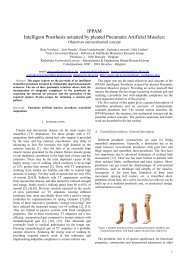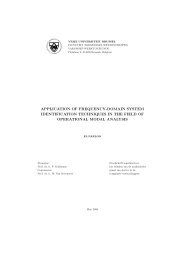VRIJE UNIVERSITEIT BRUSSEL Acoustics - the Dept. of ...
VRIJE UNIVERSITEIT BRUSSEL Acoustics - the Dept. of ...
VRIJE UNIVERSITEIT BRUSSEL Acoustics - the Dept. of ...
You also want an ePaper? Increase the reach of your titles
YUMPU automatically turns print PDFs into web optimized ePapers that Google loves.
3.2. THE MEASUREMENT MICROPHONE 37Figure 3.3: Frequency response <strong>of</strong> <strong>the</strong> different standard microphone sizes.Source: Bruël&Kjær.The three types <strong>of</strong> microphones can also be used in ano<strong>the</strong>r field than<strong>the</strong> one <strong>the</strong>y are developed for : pressure microphones can be used in diffusefields. If a free field microphone is used in a diffuse field, an electronic correctionmust be carried out. When a random incidence microphone is usedin a free field, <strong>the</strong> microphone must be turned 70 circ to 80 circ relative to <strong>the</strong>source <strong>of</strong> <strong>the</strong> sound. A pressure microphone must be placed at a 90 circ anglerelative to <strong>the</strong> direction <strong>of</strong> <strong>the</strong> source. The National American Standards Institute(ANSI) relies on <strong>the</strong> use <strong>of</strong> random incidence microphones to composeits standards, <strong>the</strong> International Electrotechnical Commision (IEC) relies onfree field microphones (see Figure 3.5). In Belgium, norms legislation andregulations prescribe apparatus that comply with <strong>the</strong> IEC-guideline.3.2.3 Influence <strong>of</strong> <strong>the</strong> wind speedIt is common knowledge that wind in <strong>the</strong> vicinity a microphone producesadditional noise. This pollutes <strong>the</strong> signal. For measurements in open air, itis <strong>the</strong>refore advised to use a windscreen (this is a s<strong>of</strong>t foam rubber sphere,as can be seen in Figure 3.6). Windscreens are essentialy transparent in <strong>the</strong>interesting frequency range. Typical values are a weakening <strong>of</strong> 0.5 dB at 5kHz, this increases to 2 dB weakening at 12 kHz. Figure 3.7 displays <strong>the</strong>
















